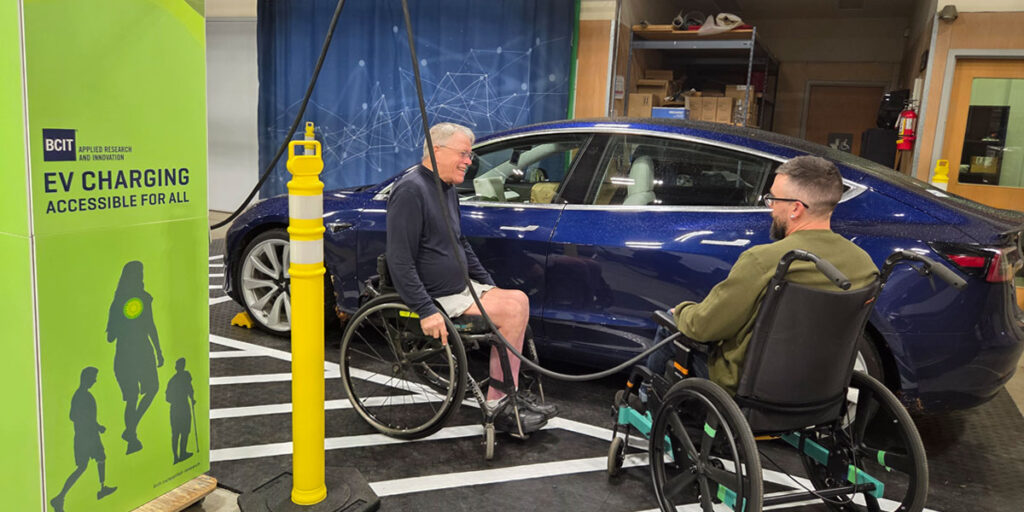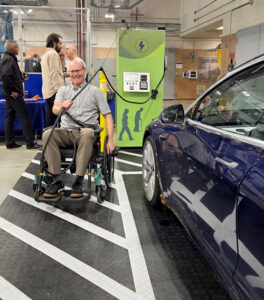
Public EV charging infrastructure is expanding rapidly, faster than design standards can keep up. Surging demand for EV’s has led to stations being installed at an unprecedented pace with Canada’s public EV-charging network growing by more than 32 per cent between March 2023 and March 2024 alone.

Unlike gas stations, which have had decades to standardize layouts and integrate accessibility features, EV charging remains an emerging field with few established design norms or accessibility standards. The CSA Group has warned that most existing charging sites are not universally accessible, especially for people who rely on wheelchairs or other mobility aids, and that is a lot of people. According to the 2022 Canadian Survey on Disability, 27 percent (more than one in four) Canadians aged 15 and up have a disability that limits daily activities, and nearly 40 percent of those report mobility challenges.
As governments and utilities race to expand the network, accessibility is often treated as an afterthought, yet for millions of Canadians, it determines whether they can fully participate in the shift to clean transportation.
This is where BCIT researchers come in.
A research-driven approach to inclusion

BCIT researchers Joey Dabell, Project Leader with the Smart Microgrid Applied Research Team (SMART) and Yvette Jones, Project Leader with the MAKE+ applied research group are collaborating to identify what works, and what doesn’t, for people with diverse accessibility and mobility needs when charging an EV in public spaces.
Who is having trouble using EV chargers and what are the challenges? What changes could improve the EV charging experience and the current state of best practices?
Using a life-sized, modular EV charger and parking space mock-up, the team is testing real-world scenarios with participants who have a broad range of mobility and cognitive challenges, including people in wheelchairs, people with strollers, canes, temporary injuries and even hidden disabilities that impair cognition. The adjustable mock-up allows researchers to adjust factors such as cable height, screen placement, reach distance, and physical layout and spacing to assess usability, comfort and safety.
Defining what accessible EV charging should look like in Canada

Armed with this information and a comprehensive review of both North American and international best practices and standards, the team is pinpointing where improvements are needed before large-scale infrastructure investments are made. Their findings will help shape design recommendations and lay the groundwork for future universal design standards in EV charging infrastructure.
“Our work with CSA Group is defining what accessible EV charging should look like in Canada. We’re helping to lay the groundwork for Canada’s first national accessibility guideline and eventual standard for electric vehicle charging infrastructure.
The research brings together the lived experiences of drivers with disabilities, charger manufacturers, utilities, and municipalities to identify design barriers and inform practical solutions that ensure charging is usable by everyone” says Dr. Yvette Jones.
Next steps
As the project moves into its next phase, the team is focusing on how to turn lessons learned into broader awareness and action. “This work has reminded us of the values that are integral to how we teach and do design, including the importance of empathy through experience, inclusion through co-design, and collaboration across sectors. These reminders and lessons learned will drive our next steps to expand our outreach as we partner to take the Accessible EV Charging Mock-up space on the road as a traveling interactive exhibit to spark dialogue, hands-on learning, and innovative solutions,” says Joey Dabell, Project Leader, SMART.
Special thanks

This research project was made possible through the collaboration of many dedicated individuals and partners. Special thanks to MAKE+ researchers Rory Dougall, Thom Bellaire and the BCIT Graphic Communications program for their their combined work to construct, design and print the facade for the EV charger mock-up. The team is also grateful for the support and guidance of Dr. Jaimie Borisoff and Jacques Courteau.
This project was made possible with funding and project assistance from the BCIT Institute Research Funds, CSA Group, and NRCan’s ZEVAI program.
In remembrance of Kelly Carmichael (1969–2024).
About SMART and MAKE+
This interdisciplinary project draws on the strengths of applied research groups SMART and MAKE+, blending engineering and human-centred design to create practical, inclusive solutions for accessible EV charging.
Smart Microgrid Applied Research Team (SMART) – Represented by Project Leader Joey Dabell, SMART conducts applied research in clean-energy systems, including EV charging infrastructure, microgrids, and grid integration. The team focuses on practical, scalable solutions that support Canada’s transition to sustainable and resilient energy networks.
MAKE+ product development applied research group – Represented by Project Leader Yvette Jones, MAKE+ specializes in human-centred design, adaptive technologies, and accessibility innovation. The group’s expertise in ergonomics, usability, and inclusive product development ensures that new technologies are responsive to the needs of a diverse range of users.